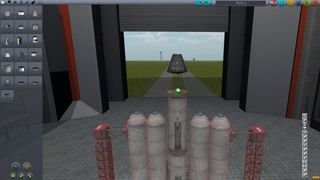Kerbal Space Program chronicle — part two: the first Kerbal in space

Kerbal Space Program is an open-world universe simulator that specializes in modeling orbits, atmosphere, gravity and rocket physics. With nothing but your wits and an array of space vehicle parts, your task is to explore. In this chronicle, I will be recording the first missions of the PCGSA, PC Gamer's ambitious new space program. If you want to get caught up, start from part 1 .
Last week, we successfully launched our first satellite into a stable near-Kerbin orbit. Today will be a day that heroes are made: the first Kerbal in space will orbit a few times and come home to an adoring public. Let's get him there and back again safely, shall we?

I'm once again in the Vehicle Assembly Bay having massive hunks of steel attached and detached at random. My engineers make construction seem so easy, snapping parts off and on at my order. They must be really handy around the house, these Kerbals.
Adapting rockets is simple: I just pull up the schematics for PCG 1, the satellite already in orbit, and saw off the satellite part. Setting aside the lifting rockets, I get PCG 2 started with a new central pod. Every spacecraft needs a command module, but this time the module needs to support life and keep one of our highly trained Kerbal pilots from going splat-pop-sizzle. I bring in the Command Pod Mk. 1, a small, lightweight, single-Kerbal module that comes complete with a window. The luxury!

PCG 2 requires a few basics. I need the RCS and stability systems, as well as a battery and a few small solar panels. A small fuel tank and efficient engine wouldn't be enough to break Kerbin's gravity and reach orbit, but according to our scientists they'll work just fine to come down again. Finally, but perhaps most importantly, a parachute nose cone. This strip of silk will be the most crucial piece of equipment in the entire mission: smoking craters don't look very good in photo ops.
I get a tap on the shoulder, and it's an officer from our Kerbal Resources department. Uh-oh. Do I remember what happened last time? Yes, I do. Am I aware that there's a real live Kerbal on the rocket this time? Yes, I am. After a thorough scolding and a referral to our health insurance providers, I do myself a favor and double-check the staging, and it's a good thing I did. Sometimes disassembling a rocket can scramble the automatic staging set up by our computers, and another embarrassing mistake would have meant a lot of paperwork.

Once again, we're on the launch pad. Young go-getter Wildo Kerman drew the short straw in the pilots' lounge to fly this mission, so he's strapped in. The throttle's up. Let's make history.
PC Gamer Newsletter
Sign up to get the best content of the week, and great gaming deals, as picked by the editors.
Most Popular







